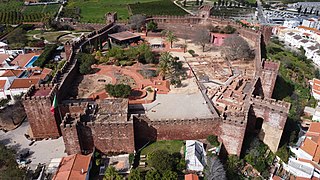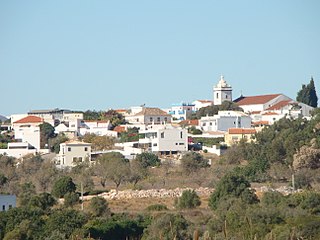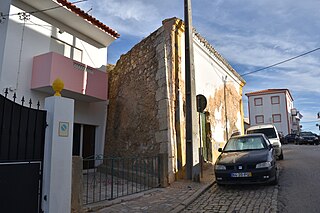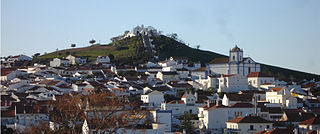
Alcantarilha is a former civil parish in the municipality of Silves, Portugal. In 2013, the parish merged into the new parish Alcantarilha e Pêra. With an area of 19.54 square kilometres (7.54 sq mi) the population of 2347 inhabitants is dispersed throughout the territory.

Paderne is a village and civil parish in the municipality (concelho) of Albufeira, in the Portuguese region of Algarve. The population in 2011 was 3,304, in an area of 52.56 km².

The Castle of Paderne is an ancient fortification located in the civil parish of Paderne, municipality of Albufeira, in the Portuguese Algarve. It was constructed in the later 12th century by Berbers, in an area around 7.5 kilometres (4.7 mi) inland.

The Castle of Silves is a castle in the civil parish of Silves in the municipality of Silves in the Portuguese Algarve. It's believed that the first fortifications were built upon a possible Lusitanian castro, by the Romans or Visigoths. Between the 8th and 13th centuries, the castle was occupied by the moors who expanded it, making it one of the best preserved Moorish fortifications in Portugal, resulting in its classification as a National Monument in 1910.

Ferragudo is a Portuguese civil parish at the western border of the municipality of Lagoa. The population in 2011 was 1,973, in an area of 5.41 km². Ferragudo serves mainly as a bedroom community for its much larger neighbour, the city of Portimão; its residents routinely travel across the Arade River to work in the neighboring municipality.

The Fort of São João do Arade, sometimes referred to as the Castle of Arade, is a medieval fortification situated in the civil parish of Ferragudo in the Portuguese Algarve municipality of Lagoa.

The Castle of Viana do Alentejo is a gothic castle constructed during the reconquest and settlement of the central region of the Portuguese Alentejo, located in the parish of Viana do Alentejo, municipality of the same name. Although a relatively low-profile design, in comparison to its contemporaries, the structure served the period of strife associated with expansion of Portuguese forces/authority into the southern Algarve.

The Castle of Carrazeda de Ansiães, normally shortened to Castle of Ansiães, is a medieval castle in the civil parish of Lavandeira, municipality of Carrazeda de Ansiães of Portugal.

The Fort of Nossa Senhora da Rocha is a medieval castle situated in the civil parish of Porches, in the municipality of Lagoa in Portuguese Algarve. Inside the fort is the Chapel of Nossa Senhora da Rocha, of uncertain date.

Mexilhoeira Grande is a civil parish in the municipality (concelho) of Portimão in the southern Portuguese region of the Algarve. The population in 2011 was 4,029, in an area of 91.15 km².

The Castle of Alcoutim is a medieval castle in the civil parish of Alcoutim, in the municipality of the same name, in the southeastern Algarve of Portugal. Built in the 13th century, the castle stands in a dominant position on a hill south of the parish seat of Alcoutim on the right bank of the San Marcos River, opposite the territory of Sanlúcar de Guadiana.

The Castle of Alcantarilha is a medieval fortress and its remnant walls in Portugal, in the civil parish of Alcantarilha, municipality of Silves, in the Portuguese Algarve region of southwestern Iberia. It is a little-known monument, now in ruins, used for the protection of the people of the village and surrounding area from attacks by north African pirates.

The Castle of Aljezur is a medieval castle founded in the parish of Aljezur, in the municipality of the same name overlooking the Aljezur River. Excavations in the castle have discovered that the location was occupied during the Bronze and Iron Ages, while the parade grounds, habitational structures, and two silos date to the 12th and 13th centuries.

The Castle of Castro Marim is a medieval castle on a hilltop overlooking the civil parish of Castro Marim, in the municipality of the same name, in the Portuguese Algarve. The castle was part of the defensive line controlled by the Knights Templar, a stronghold used during the Portuguese Reconquista, and adapted during the Restoration War to defend the frontier.

The Roman Ruins of Cerro da Vila are the remnants of a historical villa in the Algarve region of southern Portugal. Its vestiges lie in the vicinity of the resort and marina of Vilamoura, in the civil parish of Quarteira, municipality of Loulé Municipality.

Castle of Loulé is a castle in the municipality of Loulé, in the Portuguese Algarve. Classified a National Monument, since 20 June 1924, three towers remain within the cordon of walls, the remnants of the town hall located within the structure.

The Castle of Aljustrel, is a Portuguese medieval castle in civil parish of Aljustrel e Rio de Moinhos, in the municipality of Aljustrel, in the district of Beja.

The Castle of Folgosinho, is a medieval castle in the civil parish of Folgosinho, municipality of the Gouveia in the district of Guarda in the Centre region of Portugal.

The Fort Nossa Senhora da Luz, also known locally as Castle of Senhora da Luz is a fort in the civil parish of Luz, municipality of Lagos in the Portuguese Algarve, classified as a Property of Public Interest.
























